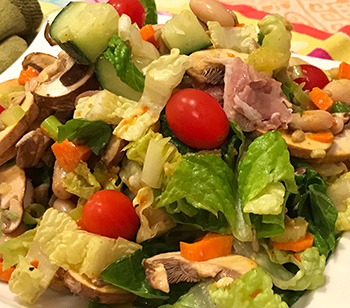Chef Tim Says...
| Salad in a Jar Construction Kit | 08/03/20 |
| Cooking: the real aromatherapy | 05/18/20 |
| Get Started Cooking with Stews | 01/09/20 |
| Paella | 07/16/18 |
| How to make your own shrimp stock | 10/09/17 |
| All "Chef Tim Says..." Columns | |
Dr. Tim Says...
| Not So Magic Rice | 04/09/18 |
| Leaky Gut Syndrome Quackery | 10/02/17 |
| 4 ways to protect your brain with diet | 07/18/17 |
| Chicken skin: to eat, or not to eat | 06/19/17 |
| Change is here | 06/12/17 |
| Medical technology | 03/27/17 |
| All "Dr. Tim Says..." Columns | |
Chef Tim Says....
Mustards
The Christmas Basket Challenge, Part 5
Part 1 | Part 2 | Part 3 | Part 4 | Part 5
I am nearing the end of using the ingredients in the Christmas basket that my brother and his family gave me for a present this year. There have been a lot of great recipes, some failures, and a few that have taken a lot of time and refinement. It has been tremendous fun and I am going to continue to report on seeking out and using ingredients that you might not otherwise consider for your own kitchen in future newsletters.
Our Thursday Dr. Gourmet Newsletter is usually a weekly report of new recipes, but this week I am going to talk about mustard - with some recipes included.
There were two jars of mustard in the basket, both from a French company, Edmond Fallot. One is a tarragon flavor and the other is labeled Provençale Dijon Mustard. Checking the label, there is an ingredient listing but no nutrition facts. Corresponding via email with the company (who was amazingly responsive), these are higher in sodium at about 100 milligrams per teaspoon, but Wow! is there a lot of flavor (and the company tells us they are gluten free).
The tarragon mustard is quite strong - maybe too strong for many folks. If you like sharp flavors like horseradish and wasabi, however, this mustard is for you. The thing about tarragon is that a little goes a long way and too much can bring a harsh, bitter flavor to dishes. This mustard is right on the edge of that, with a great tarragon flavor that is intense but balances well on sandwiches and in recipes as long as you use it carefully. The Provençale version is milder, with the flavors of roasted red pepper, oregano, and basil. Specialty mustards like this make great additions to your sandwiches and should be a part of your Sandwich Construction Kit. (Here's the GERD-Friendly Sandwich Construction Kit.)
Besides sandwiches, when I think of mustard, I think of vinaigrette, because I'm almost always using mustard in a vinaigrette. A tablespoon or so of Dijon or coarse ground mustard can go a long way in adding rich flavor to your vinaigrette, but it also makes the salad dressing creamier and richer. For example, using a tablespoon of extra virgin olive oil, two teaspoons of white wine vinegar, and two tablespoons of the Fallot Provençale mustard makes a terrific dressing.
Lastly, either of these specialty mustards will make a great addition to your marinade or rub. For example, this Maple Mustard Pork Chops recipe would be great with either of these mustards. Or this Chicken with Tarragon Mustard Cream would be super easy (use the Fallot Tarragon Mustard instead of the tarragon and the mustard in the recipe).

